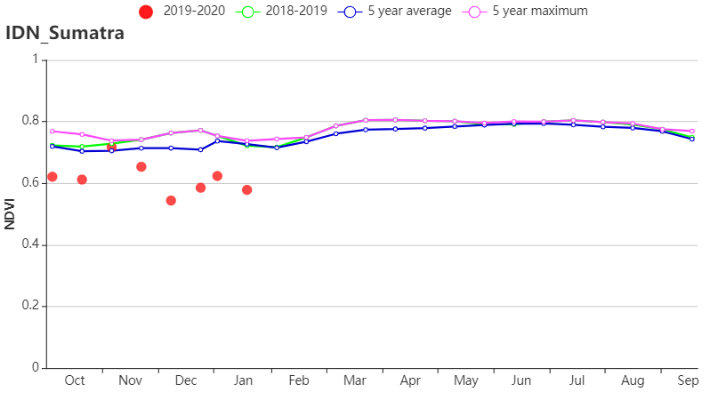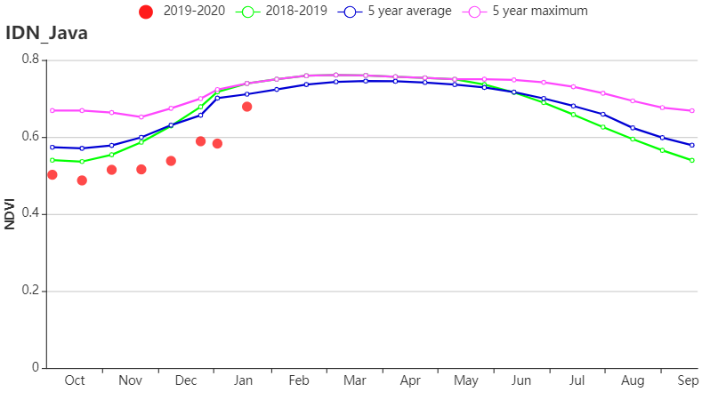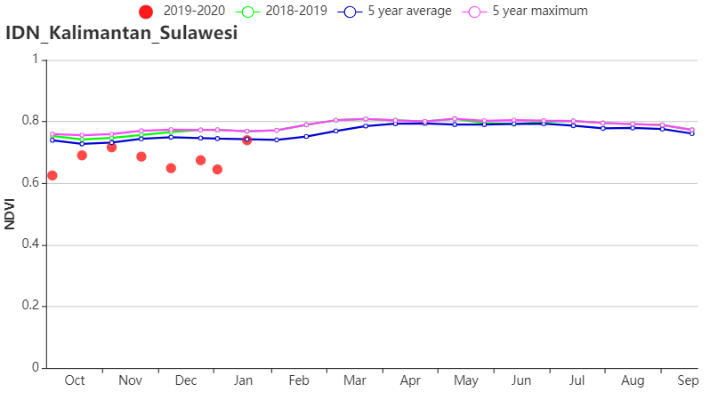From October 2019 to January 2020, the harvest of the secondary maize was completed and the main season maize was sown in Java and Sumatra; Correspondingly, main season rice was planted while the second rice in Java reached maturity and was harvested. Rainfall (RAIN, -11%) was below average while temperature (TEMP, +0.2℃) and radiation (RADPAR +9%) were slightly above, which led to an increase of biomass production potential (BIOMSS, 6%). Crop condition was slightly below average as shown in the NDVI development graph. Spatially, crop condition in 39.6% of the cropped area was close to average. In 11.7% of cultivated area, mostly located in Sumatera Barat, Sumatera Selatan, Jambi, Sumatera Barat and Riau, crop conditions were slightly below average at be beginning of this period but continued to deteriorate to significantly below average. Crop condition on 18.9% cropland, the condition was significantly below average. However, they recovered to slightly below average afterward. Considering that the area of cropped arable land (CALF) in the country was average compared with the five-year average and the VCIx value of 0.95, the crop condition is nevertheless anticipated to be slightly below average.
Regional analysis
The analysis below focuses on four agro-ecological zones, namely Sumatra (92), Java (90, the main agricultural region in the country), Kalimantan and Sulawesi (91) and West Papua (93), among which former three are relevant for crops cultivation. The numbers correspond to the labels on the VCIx and NDVI profile maps.
The weather over Java was relatively dry. RAIN was below average (-38%), whereas radiation (RADPAR +10%) and temperature (TEMP,+0.6℃) were above average, resulting in close to average (+3%) biomass production potential. According to the NDVI development graph, crop condition was below the 5-year average. Overall, the crop conditions in Java are assessed as fair.
Kalimantan and Sulawesi experienced the same patterns as the rest of the country: Rainfall (RAIN, -8%) was below average while temperature (TEMP, +0.1℃) and radiation (RADPAR +9%) were slightly above, which led to an increase of biomass production potential (BIOMSS, 7%). According to the NDVI development graph, crop conditions were slightly below the 5-year average except for the end of October and January. Overall, the crop conditions were close to average.
The slightly below average rainfall (RAIN -7%) in Sumatra was accompanied by above average radiation (+9% departure) and temperature (+0.3℃ departure) , which resulted in slightly above average biomass production potential (BIOMSS +8%). According to NDVI development graphs, crop condition was slightly below the 5-year average except for the end of October. The crop condition in Sumatra was close to average.
Considering that all the arable land was cultivated and enough water (RAIN, 1250 mm), though slightly less than the five-year average, was available for the crops, CropWatch assesses the conditions of crops slightly below average.

Figure 3.15a. Indonesia phenology of major crops

Figure 3.15b. Indonesia national level crop condition development graph based on NDVI, comparing the October 2019 to January 2020 period to the previous season and the five-year average (5YA) and maximum

Figure 3.15c. Indonesia VCI for October 2019 to January 2020 by pixel

Figure 3.15d. Indonesia spatial NDVI patterns up to January 2020 according to local cropping patterns and compared to the 5YA (left) and (e) associated NDVI profiles (right)
![]()

Figure 3.15f. Sumatra crop condition development graph based on NDVI

Figure 3.15g. Java crop condition development graph based on NDVI

Figure 3.15h. Kalimantan and Sulawesi crop condition development graph based on NDVI
Table 3.32. Indonesia agroclimatic indicators by sub-national regions, current season's values and departure from15YA, October 2019 to January 2020
| Region | RAIN | TEMP | RADPAR | |||
| Current (mm) | Departure (%) | Current (°C) | Departure (%) | Current (MJ/m2) | Departure (%) | |
| Java | 750 | -38 | 25.8 | 0.6 | 1323 | 10 |
| Kalimantan and Sulawesi | 1180 | -8 | 24.6 | 0.1 | 1229 | 9 |
| Sumatra | 1371 | -7 | 24.3 | 0.3 | 1140 | 9 |
| West Papua | 1436 | -13 | 23.5 | 0.2 | 1116 | 9 |
Table 3.33. Indonesia agronomic indicators by sub-national regions, current season's value and departure from 15YA/5YA, October 2019 to January 2020
| Region | BIOMSS | Cropped arable land fraction | Maximum VCI | ||
| Current (gDM/m2) | Departure (%) | Current | Departure (%) | Current | |
| Java | 817 | 3 | 96 | -1 | 0.87 |
| Kalimantan and Sulawesi | 799 | 7 | 100 | 0 | 0.97 |
| Sumatra | 739 | 8 | 100 | 0 | 0.96 |
| West Papua | 710 | 6 | 100 | 0 | 0.97 |
